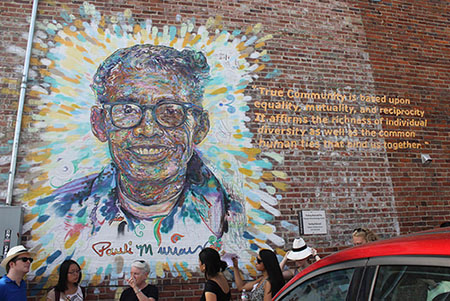20 Nov. 1910 - 1 July 1985
See also: Pauli Murray for Students; Fitzgerald, Robert George

Anna Pauline (Pauli) Murray was a lawyer, professor, writer, outspoken civil and gender rights activist, and Episcopal priest. Murray was born in Baltimore.
Murray was the fourth of six children born to parents Agnes Fitzgerald and William Murray. Pauli was also the granddaughter of Robert Fitzgerald. Fitzgerald was a free Black man who served in the Union Army during the Civil War, was a founder of Freedmen Bureau Schools in North Carolina, and the founder, along with his brother, of the Durham bank that became the Mechanics and Farmers Bank.
Murray's mother died of a cerebral hemorrhage in 1914. Murray's father suffered from chronic illness and lived in long-term care at Crownsville State Hospital. The facility was located in Crownsville, Maryland and served as a segregated facility for Black patients. While there, he was later murdered by a white guard in 1923. With no parents, Murray was sent to live with aunt, and namesake, Pauline Fitzgerald Dame of Durham.
In Durham, Murray graduated at sixteen from the segregated Hillside High School as valedictorian. After, Murray enrolled at Richmond Hill High School in New York, the only Black student, to complete high school. Murray wanted to attend an integrated college, but struggled to meet the stringent academic and financial requirements these institutions imposed on non-white learners. At Barnard, Murray matriculated at Hunter College. During this time, Murray also worked briefly at Camp Tera, a New Deal work project. While there, Murray met Eleanor Roosevelt, who would serve as a guiding force throughout Murray's life.
In 1938, Murray applied to the University of North Carolina (UNC) to study sociology. Murray's application contradicted North Carolina state law that required “separate but equal” institutions. As a result, it garnered national attention. UNC's denial of Murray's application was the first of many legal suits for racial and gendered equality that Murray would pursue while living.
Despite having served jail time for refusing to sit at the back of a bus in Virginia, Murray was admitted to Howard Law School in 1941. There, Murray experienced discrimination on the basis of gender rather than race. When awarded a fellowship to pursue advanced legal education, Murray was rejected by Harvard, again, on the basis of gender. Instead, Murray traveled to California to study for a master’s in law. The experiences with Howard and Harvard helped inform many of Murray's later arguments and publications on the basis of race and gender discrimination.
Murray published States' Laws on Race and Color in 1951. Thurgood Marshall cited the work as “the Bible for civil rights lawyers.” Murray's second book was a biographical account, and was titled Proud Shoes: The Story of an American Family (1956). In 1960, Murray travelled to Ghana to teach law at the University of Ghana and later authored the first English-language textbook on law in Africa.
Murray also worked for civil rights and women’s organizations, helped found the National Organization of Women (NOW), and was appointed by President John F. Kennedy to the Committee on Civil and Political Rights within his Commission on the Status of Women. Murray remained critical of the lack of leadership roles for women in many of the organizations. In 1970, Murray published a volume of poetry titled Dark Testament.
In 1977, Murray became the first Black American female Episcopal priest in the United States. Murray's first Eucharist was held at the Chapel of the Cross in Chapel Hill, where Murray's grandmother had been baptized while she was enslaved. About the special day, Murray wrote, "All the strands of my life had come together."
Pauli Murray died on July 1, 1985, in Pittsburgh. Murray is buried in Cypress Hill Cemetery, located in Brooklyn, New York. Murray's autobiography, Song in a Weary Throat: An American Pilgrimage, was published posthumously in 1987.